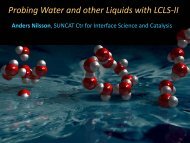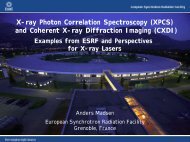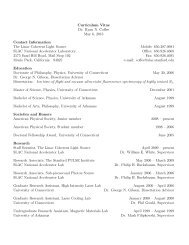SXR Technical Design Report - Stanford University
SXR Technical Design Report - Stanford University
SXR Technical Design Report - Stanford University
Create successful ePaper yourself
Turn your PDF publications into a flip-book with our unique Google optimized e-Paper software.
2. SCIENTIFIC PROGRAM<br />
2.1 Pump-Probe Ultrafast Chemistry<br />
The ultimate goal in chemistry and physical chemistry is to understand on a fundamental level how bonds break<br />
and reform during chemical reactions. In many cases we arrive at simple pictures of electron motion with respect to<br />
electron pair redistributions or electrostatic interactions along a reaction path. For many systems bonding can be<br />
understood in terms of molecular orbitals and reactivity in dynamical rearrangements of different molecular states.<br />
Such knowledge provides the basis for the understanding of chemical trends and prediction of chemical reactivity<br />
for chemical compounds. Since the excitation and probe steps with conventional optical lasers involve valence<br />
electrons that are delocalized over many atomic centers it is difficult to study complex systems. Unprecedented<br />
insight into chemical reaction dynamics would be gained by probing exactly the atomic site involved. X-ray<br />
spectroscopies can directly access molecular orbital changes associated with or even during chemical reactions. In<br />
particular, accessing core levels in the soft x-ray regime with spectroscopy opens up new prospects to study timeresolved<br />
changes in the electronic structure of complex systems containing the essential elements C, O and N or 3dmetal<br />
atoms. Detailed insight into surface reactions, catalysis, hydrogen-bonded systems and aqueous solutions can<br />
be expected.<br />
Figure 0-1. Schematic illustration of X-ray Spectroscopy. Here, the radiative decay of a core-hole in N 2<br />
adsorbed on a Ni surface by x-ray emission spectroscopy is shown. In addition to elemental sensitivity the<br />
method provides specificity to different chemical sites as shown in this example.<br />
X-ray spectroscopy has the unique ability to provide an atom-specific probe of the electronic structure. In x-ray<br />
emission spectroscopy (XES) the atomic or elemental sensitivity arises from the filling of a core hole by valence<br />
electrons from the same atomic site. In addition, core-level energy shifts (often denoted chemical shifts) connected<br />
with different environments allow for selective probing of chemically non-equivalent atoms (Figue 0-1). The final<br />
state of the x-ray emission process is a valence-hole state similar to the final state in valence band photoemission<br />
with the unique feature that the valence electronic structure is projected onto a specific atom. Notably, selection<br />
rules of XES, and similarly of X-ray photoelectron spectroscopy (XPS), in conjunction with variation of polarization<br />
4
















